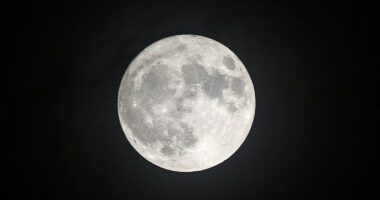THE Sun will “appear to have a bite taken out of it” later this morning as a partial solar eclipse takes places.
Skygazers will have a different view depending on where they are.
In the UK, nearly a sixth of the Sun will be blocked out by the Moon, while in western Siberia and Russia it’s expected to be a maximum of 85 per cent.
Large parts of Europe, northeast Africa, the Middle East and central Asia will get a glimpse, but those in North America will miss out this time round.
In Blighty, Scots are expected to get the best possible view.
Dr Robert Massey, of the Royal Astronomical Society, said the phenomenon will cause the Moon to block the view of “some or all of the bright solar surface”, and the Sun will “appear to have a bite taken out of it”.


Experts say the eclipse will begin at 10:08am in London, with the maximum eclipse occurring at 11.13am, when the Moon will cover close to 15 per cent of the Sun.
Lerwick in the Shetland Isles is expected to have a better view, with 28 per cent of the Sun obscured at mid-eclipse.
Jake Foster, astronomer at Royal Observatory Greenwich, said: “The eclipse will be visible across the whole of the UK, as well as large parts of Europe and Central and South Asia.
“The amount of obscuration you’ll see will depend on where you are on the Earth.
“Those viewing from the UK will see between 10 per cent and 20 per cent of the Sun covered by the Moon.”
He added: “Even though a portion of the Sun’s light will be blocked, it will not get noticeably darker in the UK during the eclipse.”
The partial eclipse will end at 11:51am.
How to watch the partial solar eclipse safely
Anyone hoping to see it has been warned not to look directly at the Sun as this can cause serious damage to the eyes, even when a large fraction of the solar disc is blocked out.
Most read in Tech
It is also not wise to look at the Sun through binoculars, telescopes or a telephoto lens on an SLR camera.
Dr Massey added: “The simplest way to watch an eclipse is to use a pinhole in a piece of card.
“An image of the Sun can then be projected on to another piece of card behind it (experiment with the distance between the two, but it will need to be at least 30 cm).
“Under no circumstances should you look through the pinhole.”
Dr Massey said another popular method used to view an eclipse is the mirror projection method.
He said: “You need a small, flat mirror and a means of placing it in the sun so that it reflects the sunlight into a room where you can view it on a wall or some sort of a flat screen.
“You may also have eclipse glasses with a certified safety mark, and these are available from specialist astronomy suppliers.
“Provided these are not damaged in any way, you can then view the Sun through them.”
Binoculars or telescopes can also be used to project the image of the Sun.
Dr Massey advised: “Mount them on a tripod, and fit one piece of card with a hole in it over the eyepiece, and place another between 50 cm and a metre behind it.


“Point the telescope or binoculars towards the Sun and you should see its bright image on the separate card.”
For those keen to follow the event, the Royal Observatory Greenwich will live-stream the eclipse on its website and YouTube channel.
Find out more about science
Want to know more about the weird and wonderful world of science? From the Moon to the human body, we have you covered…
We pay for your stories! Do you have a story for The Sun Online Tech & Science team? Email us at [email protected]
This post first appeared on Thesun.co.uk









